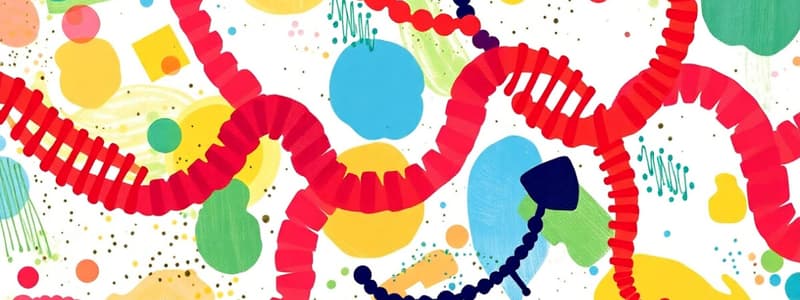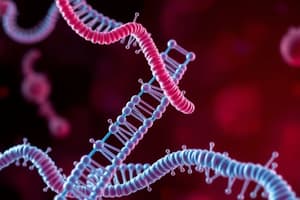Podcast
Questions and Answers
At which level can gene expression be regulated?
At which level can gene expression be regulated?
- Only during cell division
- Only at the post-translational level
- Only at the transcriptional level
- At multiple levels including transcriptional and translational (correct)
What is the role of transcriptional regulators?
What is the role of transcriptional regulators?
- They act only as repressors
- They function only in prokaryotic cells
- They can act as either activators or repressors (correct)
- They are exclusively involved in translation
Which mechanism describes the way the Lac operon is controlled in bacteria?
Which mechanism describes the way the Lac operon is controlled in bacteria?
- Through both activation and repression (correct)
- Only by transcriptional activation
- By post-translational modification only
- Independent of any environmental factors
Which of the following represents a conserved cell-cell signaling pathway in animal development?
Which of the following represents a conserved cell-cell signaling pathway in animal development?
What does the genome in somatic cells indicate regarding gene expression?
What does the genome in somatic cells indicate regarding gene expression?
What is the primary function of the TATA Box in the context of eukaryotic transcription?
What is the primary function of the TATA Box in the context of eukaryotic transcription?
Which molecule binds to the TATA Box to facilitate the recruitment of RNA Pol II?
Which molecule binds to the TATA Box to facilitate the recruitment of RNA Pol II?
What is the role of RNA Pol II in eukaryotic cells?
What is the role of RNA Pol II in eukaryotic cells?
What event follows the recruitment of RNA Pol II at the promoter region?
What event follows the recruitment of RNA Pol II at the promoter region?
Why is the process of eukaryotic transcription described as complex?
Why is the process of eukaryotic transcription described as complex?
What is the primary function of enhancers in gene regulation?
What is the primary function of enhancers in gene regulation?
Where can enhancers be located in relation to the genes they regulate?
Where can enhancers be located in relation to the genes they regulate?
What role does the Mediator complex play in transcription?
What role does the Mediator complex play in transcription?
What mechanism allows transcription activators to facilitate the initiation of transcription?
What mechanism allows transcription activators to facilitate the initiation of transcription?
How does the sonic hedgehog (Shh) gene influence limb development?
How does the sonic hedgehog (Shh) gene influence limb development?
What effect can a single base pair change in the enhancer of Shh cause?
What effect can a single base pair change in the enhancer of Shh cause?
What distance can enhancers be located from the transcription start site?
What distance can enhancers be located from the transcription start site?
Which statement about enhancers is false?
Which statement about enhancers is false?
What is the primary function of differential gene expression in cells?
What is the primary function of differential gene expression in cells?
Which of the following best describes gene expression?
Which of the following best describes gene expression?
Which mechanism is NOT commonly involved in the control of gene expression?
Which mechanism is NOT commonly involved in the control of gene expression?
What role do transcriptional activators play in gene expression?
What role do transcriptional activators play in gene expression?
Which component of prokaryotic transcription is located upstream of the transcription start site?
Which component of prokaryotic transcription is located upstream of the transcription start site?
How do transcriptional repressors function in gene regulation?
How do transcriptional repressors function in gene regulation?
What characterizes the operon in prokaryotic gene regulation?
What characterizes the operon in prokaryotic gene regulation?
Which of the following statements about DNA binding domains is true?
Which of the following statements about DNA binding domains is true?
What makes the Lac operon a useful model system for studying gene regulation?
What makes the Lac operon a useful model system for studying gene regulation?
Which type of gene regulation is most common during cellular development?
Which type of gene regulation is most common during cellular development?
What is the role of allolactose in the regulation of the Lac operon?
What is the role of allolactose in the regulation of the Lac operon?
What effect does glucose have on transcription of the Lac operon?
What effect does glucose have on transcription of the Lac operon?
How does cAMP contribute to the regulation of the Lac operon?
How does cAMP contribute to the regulation of the Lac operon?
What happens to the transcription of the Lac operon when both glucose and lactose are present?
What happens to the transcription of the Lac operon when both glucose and lactose are present?
What role does the CAP activator play in the Lac operon regulation?
What role does the CAP activator play in the Lac operon regulation?
What happens to the Lac operon when lactose is not present?
What happens to the Lac operon when lactose is not present?
How does the presence of glucose affect cAMP levels in E. coli?
How does the presence of glucose affect cAMP levels in E. coli?
What is the primary carbohydrate source that E. coli prefers when both glucose and lactose are available?
What is the primary carbohydrate source that E. coli prefers when both glucose and lactose are available?
Which of the following is NOT associated with the Lac operon regulation?
Which of the following is NOT associated with the Lac operon regulation?
What keeps the Lac promoter inactive even when allolactose inhibits the repressor?
What keeps the Lac promoter inactive even when allolactose inhibits the repressor?
Flashcards
Promoter
Promoter
A DNA sequence that controls the transcription of a gene.
Transcriptional Regulators
Transcriptional Regulators
Proteins that bind to DNA and regulate the transcription of genes. They can act as either activators, which increase transcription, or repressors, which decrease transcription.
Transforming Growth Factor-ß (TGFß) Pathway
Transforming Growth Factor-ß (TGFß) Pathway
A type of cell-cell signaling pathway that plays a crucial role in animal development. It is involved in a variety of processes, including cell fate determination, tissue patterning, and organogenesis.
Wnt Pathway
Wnt Pathway
Signup and view all the flashcards
Sequential Induction
Sequential Induction
Signup and view all the flashcards
Gene expression
Gene expression
Signup and view all the flashcards
Differential gene expression
Differential gene expression
Signup and view all the flashcards
Operon
Operon
Signup and view all the flashcards
Transcriptional activator
Transcriptional activator
Signup and view all the flashcards
Transcriptional repressor
Transcriptional repressor
Signup and view all the flashcards
Operator
Operator
Signup and view all the flashcards
Lac operon
Lac operon
Signup and view all the flashcards
CAP binding site
CAP binding site
Signup and view all the flashcards
TATA Box
TATA Box
Signup and view all the flashcards
TATA-binding protein (TBP)
TATA-binding protein (TBP)
Signup and view all the flashcards
General Transcription Factors (GTFs)
General Transcription Factors (GTFs)
Signup and view all the flashcards
RNA Polymerase II
RNA Polymerase II
Signup and view all the flashcards
DNA unwinding
DNA unwinding
Signup and view all the flashcards
Lac Repressor
Lac Repressor
Signup and view all the flashcards
Allolactose
Allolactose
Signup and view all the flashcards
CAP (Catabolite Activator Protein)
CAP (Catabolite Activator Protein)
Signup and view all the flashcards
cAMP (Cyclic AMP)
cAMP (Cyclic AMP)
Signup and view all the flashcards
Transcription
Transcription
Signup and view all the flashcards
Enhancers
Enhancers
Signup and view all the flashcards
DNA Looping
DNA Looping
Signup and view all the flashcards
Mediator Complex
Mediator Complex
Signup and view all the flashcards
Sonic hedgehog (Shh)
Sonic hedgehog (Shh)
Signup and view all the flashcards
Limb-Specific Enhancer
Limb-Specific Enhancer
Signup and view all the flashcards
G to A mutation in Shh enhancer
G to A mutation in Shh enhancer
Signup and view all the flashcards
1x10⁶ base pairs
1x10⁶ base pairs
Signup and view all the flashcards
Context-Dependent Response
Context-Dependent Response
Signup and view all the flashcards
Study Notes
Gene Expression Regulation
- Gene expression can be controlled at multiple levels, both transcriptional and post-transcriptional.
- Transcriptional regulation is a critical stage and is often slow-acting but energy-efficient for long-term control.
- Post-transcriptional regulation focuses on steps after transcription and mostly consists of fast-acting and reversible controls.
Prokaryotic Transcriptional Regulation
- Promoters are DNA sequences bound by RNA polymerase to initiate transcription.
- These sequences are located upstream of the transcription start site.
- Promoters show variable strength in binding RNA polymerase, influenced by regulatory proteins.
- Activating proteins increase promoter activity, while repressors inhibit.
- Activator and repressors can work in conjunction to enhance the control of transcription by creating a sensitive process.
The Lac Operon
- A bacterial operon is a cluster of genes transcribed from a single promoter.
- The Lac operon is a model system for studying gene regulation in bacteria.
- It controls gene expression for lactose utilization, only functioning when glucose levels are low.
- Transcription of the Lac operon genes involves CAP (cyclic AMP activator protein) and a repressor that works in tandem.
- Lac repressor binds to the operator when there's no lactose, preventing transcription.
- Allolactose, a lactose metabolite, binds to and inactivates the repressor, enabling transcription.
Eukaryotic Transcriptional Regulation
- Eukaryotes use three RNA polymerases, with RNA polymerase II focusing on mRNA transcription.
- A TATA box is a DNA sequence recognized by TBP (TATA Binding Protein), which is a part of the recruitment of general transcription factors (GTFs).
- The TBP/GTF complexes help recruit RNA polymerase II to the promoter, opening up the DNA for transcription initiation.
- Enhancers are regulatory DNA sequences that control gene transcription. They can be upstream or downstream to the genes they regulate or very far away. They act at a distance and play a crucial role during development.
- The mediator protein links enhancer proteins with general transcription factors, and DNA looping, bringing them together to form a complex that influences transcription.
Shh Regulation
- The Sonic Hedgehog (Shh) protein regulates anterior-posterior patterning.
- Expression of Shh is controlled by limb-specific enhancers.
- A single base-pair change can cause ectopic expression or Shh having significant outcomes in limb development.
- Shh limb enhancers are conserved in several species (mouse, human, fish).
Studying That Suits You
Use AI to generate personalized quizzes and flashcards to suit your learning preferences.
Related Documents
Description
This quiz explores the regulation of gene expression, focusing on transcriptional and post-transcriptional mechanisms. It includes an in-depth look at the Lac operon, illustrating how genes are clustered and controlled through promoters and regulatory proteins. Test your understanding of these essential biological concepts!




